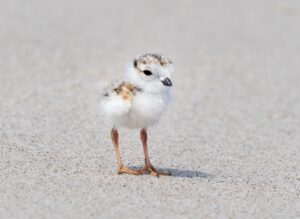WELLFLEET — Nearly 40 years ago the plump, sand-colored shorebird known as the piping plover was on the verge of extinction in Massachusetts. Now, following decades of conservation, the birds have had their best year on record — 1,145 pairs nested in Massachusetts this summer, according to a Nov. 14 Mass Audubon report on data compiled by the state Div. of Fisheries and Wildlife.

Cape Cod is an “incredibly important” part of the piping plovers’ success story, according to Lyra Brennan, director of Mass Audubon’s coastal waterbird program, which monitors the plovers on public and private beaches around the state. The Cape hosts the largest concentration of these birds in Massachusetts, a fact she attributes to its “pristine” habitat.
The numbers show that plover conservation efforts “have been really, really effective,” said Brennan. “I think we’ve got a winning formula right now.”
The 2023 numbers represent a 500-percent increase in piping plover populations in the state since 1986, when the species was listed as threatened by the U.S. Fish and Wildlife Service. Over half of the bird’s population on the Atlantic coast currently breeds in Massachusetts.
This year’s surveys found piping plovers breeding in all four towns on the Outer Cape.
The plovers are not yet in the clear, however. The species as a whole is still listed as threatened. The Great Lakes population is considered endangered, while the Great Plains and Atlantic populations are threatened.
The Long Road to Recovery
Piping plovers are beachgoing birds, and they nest on the sand between the dunes and the high tide line — a habitat that is also popular with people. It’s “right where you want to put your beach chair,” Brennan said.
Coastal development and human disturbance — cars, off-leash dogs, and crowded beaches — caused this bird’s population to plummet over the course of the 20th century. “If you think about hundreds of nests out on the beach with no protection, you can guess what would happen to them if there’s lots of unregulated activities,” Brennan said.
By 1986, only about 135 pairs were left in Massachusetts, and the birds received federal protection as a threatened species. That same year, Mass Audubon began its coastal waterbird program to monitor and protect beach-nesting birds like piping plovers.
Each year, Mass Audubon hires between 35 and 45 seasonal staff to walk and drive Massachusetts beaches looking for plover nests. Nests are monitored until chicks emerge from the eggs. Staffers then track these young until they have fledged. They also construct rope fences around nesting areas to discourage people from approaching.
Mass Audubon monitors about a third of the piping plover population, including on the bay side in Wellfleet, Truro, and Eastham. The National Park Service oversees the monitoring program on Seashore property. Elsewhere in the state, the Dept. of Conservation and Recreation, the Trustees of Reservations, and towns like Sandwich run their own monitoring programs as well.
The data these groups collect are crucial, Brennan said. “Every beach is so different,” she said, so it is vital to understand how the birds are recovering in different locations.
By comparing this information with data on habitat, predators, and human interference at each site, scientists can find commonalities among productive or unproductive beaches — data used by legislators and landowners to design management plans.
The plovers need a buffer zone around them when they are nesting, which means keeping people out of rather large portions of the beach for much of the plovers’ breeding season, which extends from late April through early September. And as populations have improved, protected areas have been enlarged to accommodate them.
Oversand vehicles are also restricted from accessing many Cape beaches during plover nesting season, especially during June and July. Vehicles are not permitted to pass within 100 feet of nests and chicks. The National Park Service, which manages an ORV corridor from Herring Cove Beach in Provincetown to Long Nook in Truro, notes that changes in access rules can occur without warning.
Management decisions like these provoke grumbling from some beachgoers. The comments under online articles about beach closures are dominated by complaints about government overreach and loss of access to favorite beaches. But the bumper stickers reading “Piping plovers taste like chicken,” which became a slogan of defiance against the protections a decade ago, are seen less often now.
Mass Audubon spends a lot of time educating the public about the plovers, Brennan said. Her organization’s monitoring staff are trained on how to talk with curious beachgoers about the birds. Back when the program was first introduced, Brennan said, the frustration among locals and tourists was palpable. Now, she said, the Mass Audubon coastal waterbird crew tracks interactions with beachgoers, and their data suggest an “overwhelmingly positive response.”
“There are still conflicts and really difficult conversations that need to be had,” Brennan said, to reach agreements that preserve both the plovers and people’s beach days.
While some people still resent the bird, Brennan said, she feels the “cultural norm has shifted to some extent. Simple things that everyone is doing are a part of the reason that the birds are succeeding.”
Other Avian Victories
While piping plovers were the stars of Mass Audubon’s report, it included good news for other waterbirds as well. American oystercatchers, huge, clownish birds with giant red bills, also had their best year ever, with 238 pairs breeding statewide — a 12-percent jump from last year’s numbers — including a few pairs in Wellfleet.
Least terns, tiny, gull-like birds that the Audubon program also monitors, experienced a slight decline from their 2022 numbers in the state, dropping from 3,691 to 3,565 pairs. Brennan noted, however, that least tern populations in Massachusetts are healthy, and regular fluctuations are normal.



